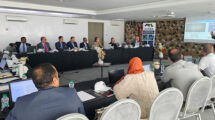On the arrival of the cable ship Ile de Bréhat to Fortaleza (Brazil), and the start of the cable landing operation of a section of the EllaLink submarine cable that will connect Europe to Latin America under the auspices of the EU-funded BELLA Programme, we had the opportunity to interview Jeremie Maillet, VP of Marine Operations for Alcatel Submarine Networks (ASN).
Can you tell us more about the cable landing operation and its challenges?
Cable landing takes place in a specific location identified by the project’s marine survey data; it’s the meeting point for the offshore and the land-based teams in charge of the landing operation. The operation starts with cable pulling, which is a key manoeuvre requiring the additional support of local sub-contractors to enable the successful transportation of the cable from the vessel onto the beach. The overall operation uses data gathered during the marine survey which, by enabling a detailed risk analysis, determines the safest and most accurate position for the cable and the cable ship. Prior to the vessel’s arrival the land team starts preparing relevant equipment and protecting the landing location area. As the weather is often one of the main factors affecting this type of operation, local and global weather forecasts are regularly monitored.
Cable pulling from the ship to the shore starts in daylight and can take a couple of hours; the cable is kept afloat with red balloons which are subsequently removed by divers. The vessel then moves to a different position to enable cable testing, after which the actual system installation can commence. The next stage is cable protection: the land team buries the cable in a trench on the beach and divers bury it in the seabed. The cable is protected using specific techniques such as water jetting (on soft seabed) or articulated steel pipes (on rocky seabed) according to marine survey recommendations.
What kind of vessel is used for the cable works? How many ships will be used for the EllaLink project? Can you tell us more about the fleet?
The EllaLink cable is split into two loads on two sister cable ships, the Ile de Bréhat which landed in Fortaleza on Monday 14 December and the Ile de Sein which is due to land in Sines (Portugal) in the coming weeks. These two ships employed for the EllaLink cable operation are part of a fleet comprising three sister ships, the third vessel is the Ile de Batz. This fleet can not only carry a large load of cables, but can also use the combined force power of towing and ploughing to enable cable burial and protection.
How will the two sections of the EllaLink cable on the ships landing in Brazil and Portugal be joined?
The Ile de Bréhat, after laying around 1700km of cable including the branching units to French Guiana and Southern Brazil, will leave the cable on the seabed. After placing a plug to the end of the cable to stop water ingress, the system will be tied to a 3km rope left in a specific location in the survey corridor and its coordinates will be sent to the Ile de Sein to ease the cable’s recovery. Once recovered, a team on the Ile de Sein will proceed to connect the fibres within the cable one by one.
How are work and life organised on board of the cable ship? What will the crews do on board during the Christmas festivities? Will they have any special celebrations?
Christmas celebrations on board will always take place even when crews are operative. Usually at the last port call before Christmas day, the crew will purchase special food for the celebrations and, if the vessel happens to be in transit, all crew members will be able to enjoy the Christmas meal together (as this is a dry fleet, there’s a strict policy of no alcohol on board). If the crew is on shifts, celebrations are split in two stages. Traditional celebrations and activities include the distribution of gifts and the display of decorations in the mess and the lounge. When the weather allows it, and if the ship happens to be in the southern hemisphere, the crew might even organise a festive Christmas BBQ! When on port calls crew members can attend Christmas mass and take part in local traditions. I remember a very pleasant, enjoyable and festive New Year’s Eve in Genoa (Italy) many years ago.
Crews can keep in regular touch with their families back home thanks to their monthly credit allocation for the use of onboard satellite communications whose bandwidth increase, in recent times, has improved quality and frequency of contact.
Is this your first participation in an R&E network?
Few years ago, we were involved in the Indigo subsea cable system between Singapore, Australia and Indonesia enabled by a consortium including AARNet, Google, Indosat, Singtel, SubPartners and Telstra. It was a remarkable project due to its logistical requirements, size and duration. And by the way, our Ile de Bréhat played a pretty big role in Indigo too.
About Jérémie MAILLET








